
Sundevall's roundleaf bat, also called Sundevall's leaf-nosed bat, is a species of bat in the family Hipposideridae.

The cyclops roundleaf bat or cyclops leaf-nosed bat is a species of bat in the family Hipposideridae found in the forests of equatorial Africa. It is placed in the genus Doryrhina together with the closely related greater roundleaf bat.
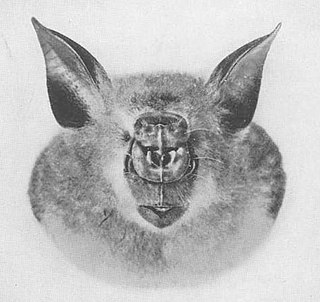
The giant roundleaf bat is a species of bat in the family Hipposideridae found in western tropical Africa. Its natural habitats are subtropical or tropical moist lowland forests and caves. The species was formerly considered part of M. commersoni, which is now viewed as being restricted to Madagascar. Both commersoni and it were formerly placed in the genus Hipposideros, but moved to the resurrected Macronycteris in 2017 on the basis of molecular evidence. It is threatened by habitat loss.

The Kolar leaf-nosed bat, or leafletted leaf-nosed bat is a species of bat in the family Hipposideridae. It is endemic to India. Its natural habitats are subtropical or tropical dry forests and caves. It is found in only one cave in India, and its population is less than 200 individuals.

The big-eared roundleaf bat is a species of bat in the family Hipposideridae. It is endemic to Indonesia, known from Kangean Islands, southwestern Sulawesi and Seram Island. It roosts in caves and tree hollows and probably forages in woodland. It is threatened by habitat loss through logging and other human activities.
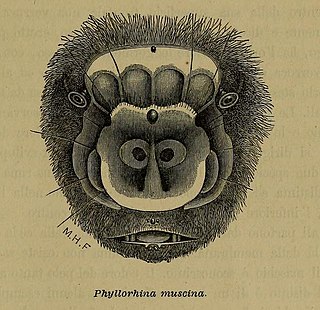
The Fly River roundleaf bat is a species of bat in the family Hipposideridae. It is found in West Papua, Indonesia and Papua New Guinea.

The Pomona roundleaf bat, Pomona leaf-nosed bat, or Andersen's leaf-nosed bat is a species of bat in the family Hipposideridae that is endemic to India.

The São Tomé leaf-nosed bat is a species of bat in the family Hipposideridae. It is endemic to the island of São Tomé, in the Gulf of Guinea off the western coast of Africa. The bat's natural habitats are subtropical or tropical moist lowland forests and caves.
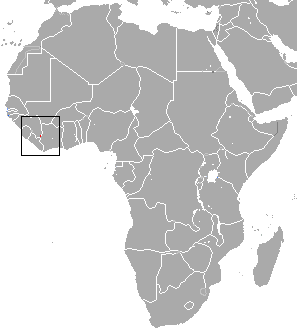
Lamotte's roundleaf bat is a species of bat found only at Mount Nimba on the border of Côte d'Ivoire, Guinea and Liberia. It is critically endangered.
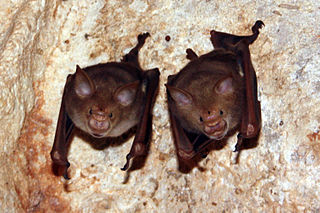
The Hipposideridae are a family of bats commonly known as the Old World leaf-nosed bats. While it has often been seen as a subfamily, Hipposiderinae, of the family Rhinolophidae, it is now more generally classified as its own family. Nevertheless, it is most closely related to Rhinolophidae within the suborder Yinpterochiroptera.
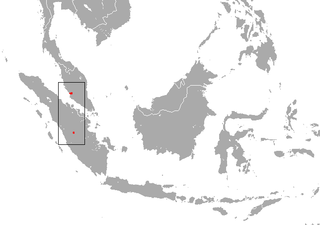
The orbiculus leaf-nosed bat, also known as the orbiculus roundleaf bat and small disc roundleaf bat, is a species of bat from the family Hipposideridae. The species has been found on the island of Sumatra in Indonesia and on peninsular Malaysia.

Commerson's roundleaf bat, also known as Commerson's leaf-nosed bat, is a species of bat endemic to Madagascar. It is named after French naturalist Philibert Commerson (1727-1773). Bat populations of Africa or São Tomé and Príncipe formerly considered part of this species are now classified separately as M. gigas, M. thomensis or M. vattatus, while one from Madagascar was split off to become M. cryptovalorona. It was formerly placed in the genus Hipposideros, but moved to the resurrected Macronycteris in 2017 on the basis of molecular evidence.

The shield-nosed leaf-nosed bat or shield-nosed roundleaf bat is a bat from Laos and Vietnam.

The Phou Khao Khouay leaf-nosed bat is a species of bat found in Laos and Vietnam. It was described as a new species in 2006. It is considered vulnerable to extinction by the IUCN.
Boeadi’s roundleaf bat is a species of roundleaf bat found in Indonesia.

Hipposideros atrox, commonly known as the lesser bicolored leaf-nosed bat, is a species of bat found in Southeast Asia. Originally described as a subspecies in 1918, it was recognized as a full species in 2010. It uses echolocation to navigate and find prey, and roosts in caves during the day.
Doryrhina is a genus of bats belonging to the family Hipposideridae. The best known species, Doryrhina cyclops, was long placed in the diverse genus Hipposideros, but a 2017 study found that it did not form a monophyletic group with true Hipposideros. Consequently, it was placed in a separate genus, Doryrhina. A second species, Doryrhina camerunensis, has not been studied genetically, but it is generally thought to be related to D. cyclops, so it was also moved to Doryrhina.
The Nicobar leaf-nosed bat is an endangered species of bat endemic to the Nicobar Islands.















